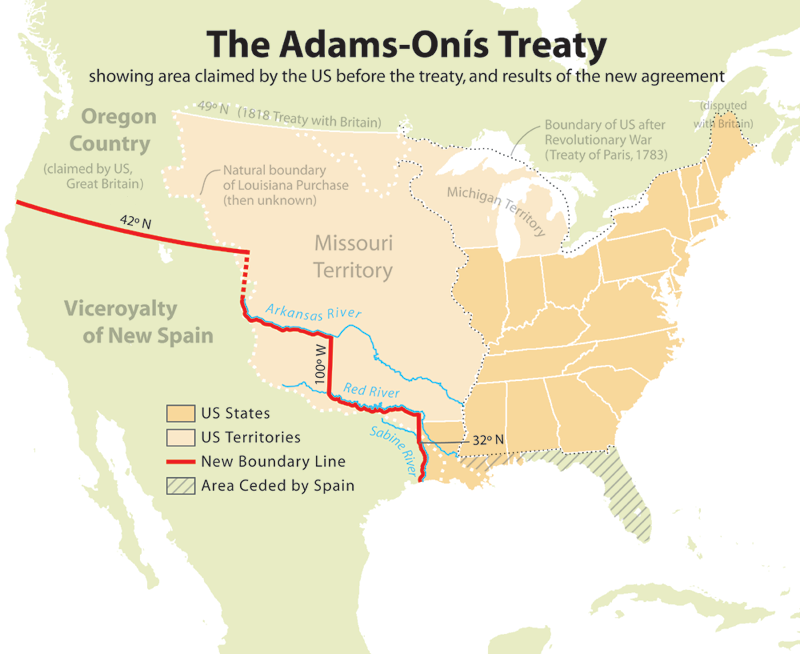
Adams–Onís Treaty
The Adams–Onís Treaty (Spanish: Tratado de Adams-Onís) of 1819,[1] also known as the Transcontinental Treaty,[2] the Spanish Cession,[3] the Florida Purchase Treaty,[4] or the Florida Treaty,[5][6] was a treaty between the United States and Spain in 1819 that ceded Florida to the U.S. and defined the boundary between the U.S. and Mexico (New Spain). It settled a standing border dispute between the two countries and was considered a triumph of American diplomacy. It came during the successful Spanish American wars of independence against Spain.
Treaty of Amity, Settlement and Limits between the United States of America, and His Catholic Majesty
Bilateral treaty
Territorial cession
February 22, 1819
February 22, 1821
April 14, 1903
English, Spanish
Florida had become a burden to Spain, which could not afford to send settlers or man garrisons, so Madrid decided to cede the territory to the United States in exchange for settling the boundary dispute along the Sabine River in Spanish Texas. The treaty established the boundary of U.S. territory and claims through the Rocky Mountains and west to the Pacific Ocean, in exchange for Washington paying residents' claims against the Spanish government up to a total of $5 million Spanish dollars[7] and relinquishing the U.S. claims on parts of Spanish Texas west of the Sabine River and other Spanish areas, under the terms of the Louisiana Purchase.
The treaty remained in full effect for only 183 days: from February 22, 1821, to August 24, 1821, when Spanish military officials signed the Treaty of Córdoba acknowledging the independence of Mexico; Spain repudiated that treaty, but Mexico effectively took control of Spain's former colony. The Treaty of Limits between Mexico and the United States, signed in 1828 and effective in 1832, recognized the border defined by the Adams–Onís Treaty as the boundary between the two nations.
Implementation[edit]
Washington set up a commission, 1821 to 1824, that handled American claims against Spain. Many notable lawyers, including Daniel Webster and William Wirt, represented claimants before the commission. Dr. Tobias Watkins served as secretary.[29] During its term, the commission examined 1,859 claims arising from over 720 spoliation incidents, and distributed the $5 million in a basically fair manner.[30] The treaty reduced tensions with Spain (and after 1821 Mexico), and allowed budget cutters in Congress to reduce the army budget and reject the plans to modernize and expand the army proposed by Secretary of War John C. Calhoun. The treaty was honored by both sides, although inaccurate maps from the treaty meant that the boundary between Texas and Oklahoma remained unclear for most of the 19th century.